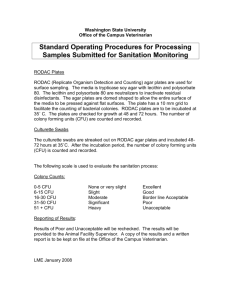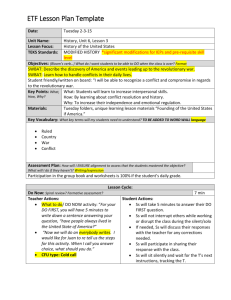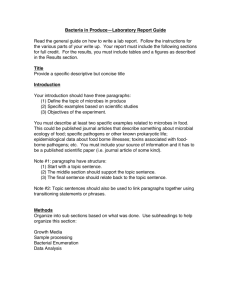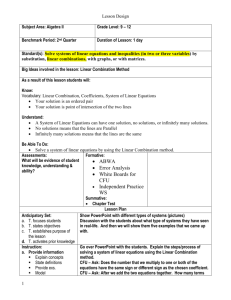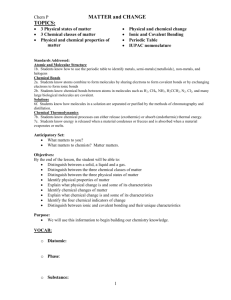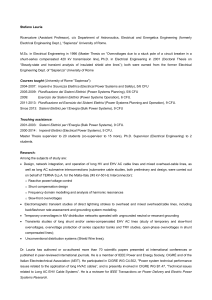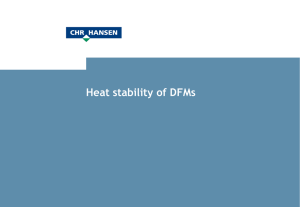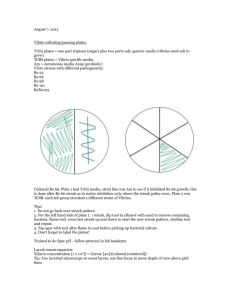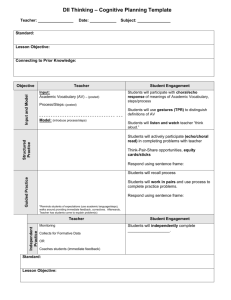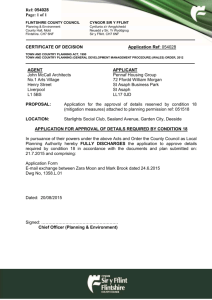High Recovery of Bacteria and Fungi in Low Concentrations from
advertisement
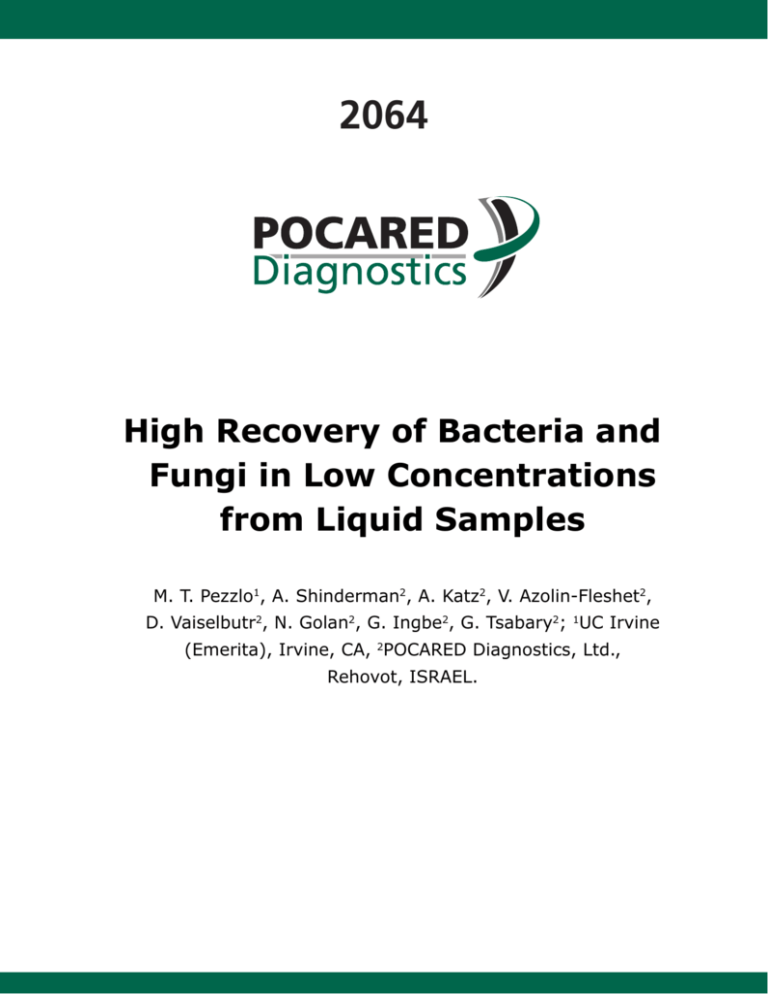
2064 High Recovery of Bacteria and Fungi in Low Concentrations from Liquid Samples M. T. Pezzlo1, A. Shinderman2, A. Katz2, V. Azolin-Fleshet2, D. Vaiselbutr2, N. Golan2, G. Ingbe2, G. Tsabary2; 1UC Irvine (Emerita), Irvine, CA, 2POCARED Diagnostics, Ltd., Rehovot, ISRAEL. 2064 High Recovery of Bacteria and Fungi in Low Concentrations from Liquid Samples M. T. Pezzlo1, A. Shinderman2, A. Katz2, V. Azolin-Fleshet2, D. Vaiselbutr2, N. Golan2, G. Ingbe2, G. Tsabary2; 1UC Irvine (Emerita), Irvine, CA, 2POCARED Diagnostics, Ltd., Rehovot, ISRAEL. Abstract Background: Use of centrifugation to concentrate microorganisms in liquid specimens may result in decreased recovery, especially when microbial concentrations are low. Methods: A study was performed to demonstrate the retention and recovery performance of the POCARED™’s Sample Processor (SP), a general purpose pre-analytical device, which has the ability to concentrate any volume of liquid samples at any concentration down to 0.1ml. Its principle mode of action is based on filtration onto a membrane filter, followed by foam extraction. Clinical isolates of Acinetobacter baumannii (AB), Escherichia coli (EC), Enterococcus faecalis (EF), Staphylococcus aureus (SA) and Candida albicans (CA) were included in this evaluation. Each isolate was prepared using a turbidity standard and diluted 10-fold in phosphate buffered saline (PBS) down to 10 CFU/ ml in a total volume of 20 ml. This volume was divided into two equal 10 ml portions; one was used as the control and inoculated onto agar plates before SP processing, while the other was processed by the SP, followed by plating onto agar plates. The plating pattern before SP processing for the two lowest concentrations, 10 CFU/ml and 102 CFU/ml, used the entire 10 ml volume. For the two highest concentrations, 103 CFU/ml and 104 CFU/ml, portions of 450µl (50µl x 9) and 90µl (10µl x 9), respectively, of the 10 ml sample were plated. The same pattern was applied following SP processing. For the two lowest concentrations the entire output volume (1.2 ml) was plated, while only portions of 90µl (10µl x 9) were plated for the two highest concentrations. The test was repeated 10 times for each isolate at each test concentration. Following incubation the results were counted and summarized. Results: The average retentions for AB, EC, EF, SA and CA at 10 CFU/ml were 75.2%, 74.8%, 68.3%, 54.8% and 105.8% respectively; for 102 CFU/ml 76.06%, 82.3%, 84.4%, 65.2% and 112.9%, respectively; for 103 CFU/ml 76.9%, 83.3%, 105.0%, 72.8% and 107.6, respectively; for 104 CFU/ml 128.8%, 120.9%, 115.3%, 98.9% and 131.9%, respectively. Conclusion: In summary, the SP is capable of concentrating liquid samples containing very low concentrations, down to 10 CFU/ml, of both bacteria and fungi with high recovery performance. -1- Introduction: Centrifugation is a common laboratory practice used to concentrate microorganisms in liquid samples. During this process cells are subjected to several times the force of gravity for the purpose of concentrating them into a pellet at the bottom of the tube. Centrifugal speed, ranging from 1,000 to 15,000 x g, causes the microorganisms to collide, which may result in cell surface damage, loss of oxygen and nutrient depletion (1). Cell surface damage during centrifugation at 15,000 x g has been shown to cause significant reductions in E. coli viability (3). The effect of centrifugation on other microorganisms has also been studied including commonly isolated species, e.g., Pseudomonas aeruginosa, Staphylococcus aureus and Staphylococcus epidermidis (2, 3) Studies have shown that centrifugal damage has been known to alter bacterial cell surface properties and interior structures, including DNA. Cell surface damage can affect the ability of bacteria to adhere to various surfaces (3). To overcome the adverse effect of centrifugation, a recent study proposed a centrifugation coefficient that can be used to predict cell surface damage and using a flat-bottomed container to minimize the pellet height (4). Although this approach may be a more accurate method than randomly selecting a centrifugation speed, it may not be practical for use in a diagnostic laboratory. Therefore, the purpose of our study was to evaluate a method that would eliminate the need for centrifugation while retaining a majority of the cells in the liquid sample. POCARED™’s SP (Figure 1), is a general purpose pre-analytical device, which was designed to overcome two major sample processing problems: a) the sampling issue – sampling utilizes only a fraction of the entire sample volume; and b) the recovery and viability of low CFU/ml samples by concentrating and fractionating any particles, such as microorganism, cells and large molecules from liquid samples. It has the ability of concentrating any sample volume down to 0.1 ml. and the ability of purifying and performing matrix/buffer exchange into any chosen liquids/ buffers. This feature is very important, especially when the samples contain growth inhibitors, e.g., antibiotics or any other interfering soluble substance. The SP principle mode of action is based on sample filtration on any type and size of membrane and extracting the particles that lie on the membrane surface by washing the membrane with foam tangentially, created by a mixture of gas, usually CO2, with any type of liquid/ buffer, e.g., water or PBS that contain surfactant. Extraction efficiency is subject to the foam quality. Some clinical specimens e.g., urine, swabs, blood, may contain low concentrations of microorganisms in relatively high sample volumes, which may be difficult to detect. In this study, we demonstrate the ability to concentrate 10 CFU/ ml in a total volume of 10 ml into 1.2 ml of PBS with high recovery performance. This study was conducted using 5 different clinical isolates representing gram-positive and gram-negative bacteria and yeast. -2- Methods: Clinical isolates of Acinetobacter baumannii (AB), Escherichia coli (EC), Enterococcus faecalis (EF), Staphylococcus aureus (SA) and Candida albicans (CA) were prepared as follows in 10 separate replicas for each isolate as illustrated in Figure 2. 1 Sample preparation: 1.1 Stock solution of 0.5 McFarland of each microorganism was prepared in PBS. 1.2 Each stock solution was serially diluted down to 10 CFU/ml using a dilution instrument in a total volume of 20 ml. Dilutions 104 down to 10 CFU/ml were processed with POCARED™’s SP. 1.3 This volume (20 ml) was divided into two equal 10 ml portions. One portion was used as the control, before SP processing, while the other was processed by the SP. 2 Sample processing using POCARED™’s SP: 2.1 10 ml of each microorganism of each replica were processed in the SP. The washing solution was PBS with 0.05% Polysorbate 20 (Tween 20) mixed with CO2 gas. This mixture created thick foam. 2.2 The foam was allowed to set for approximately one minute in order to become liquid again. The final sample volume following concentration was 1.2 ml. 3 Control and processed samples plating: 3.1 Control and SP processed samples of the two lowest concentrations, dilutions 102 and 10 CFU/ ml, used the entire 10 ml volume for plating. These samples were plated manually using spread method on blood agar for bacteria and Sabouraud dextrose agar (SDA) for yeast. 3.2 Control and SP processed samples of the two highest concentrations, dilutions 104 and 103 CFU/ ml, were plated by the Walk-Away Specimen Processing (WASP®) automated instrument (COPAN, Italy) using the 10µl loop on blood agar for bacteria and Sabouraud dextrose agar (SDA) for yeast. Processed samples for dilution 104 (1.2 ml) were diluted one level down (10-1) by adding 10.8 ml of PBS to the sample tube before placing the tube in the WASP®. 3.3 The plating volume and number of plates for each dilution are illustrated in Figure 2 and in Table 1. 3.4 All plates were incubated at 36°C for up to 48 hours. 3.5 Subsequently, the CFUs on each agar plate were counted and recorded. -3- Figure 2: Sample dilution and plating plan. Test sample concentration (CFU/ml) Unprocessed samples (control) Plating Number of volume (µl) agar plates SP processed samples Plating volume (µl) Number of agar plates 9 10(1) 9 9 10 10 9 102 50 1000 200 6 10 1000 10 1200 1 104 10 3 10 (2) Table 1: Plating volume and number of plates per each dilution. (1) Samples were diluted 10-1 before plating (2) 5 times seeding of 10µl using the 10µl loop of the WASP® -4- Results: 1 At the conclusion of each test, the average (AVG) retention percentage for each microorganism was calculated as follows: The results for each clinical isolate are presented in Abstract ,Table 2 and Figure 3. Clinical isolate AB EC EF SA CA Sample concentration target CFU/ ml Unprocessed samples AVG CFU/ml 10 100 1,000 10,000 10 100 1,000 10,000 10 100 1,000 10,000 10 100 1,000 10,000 10 100 1,000 10,000 13.3 131.8 1,792.9 19,314.8 13.5 134.9 1,996.7 24,127.4 15.18 137.1 2,015.6 29,084.8 23.0 200.8 2,402.2 32,966.7 3.4 29.7 411.6 6,488.9 SP processed samples AVG CFU/ml Retention AVG 10.0 100.3 1,370.7 24,895.6 10.1 110.7 1,664.0 29,181.3 10.3 112.7 2,099.3 33,888.0 12.6 130.8 1,717.7 32,610.7 3.6 33.4 440.9 8,546.7 75.20% 76.06% 76.90% 128.76% 74.79% 82.34% 83.29% 120.96% 68.29% 84.44% 105.00% 115.32% 54.76% 65.16% 72.82% 98.90% 105.80% 112.89% 107.58% 131.97% SD 6.50% 10.93% 6.79% 3.77% 6.89% 4.61% 6.75% 6.48% 9.76% 11.32% 12.32% 16.09% 7.89% 7.31% 14.86% 8.45% 16.77% 15.44% 12.20% 5.10% Table 2: Retention results for the 5 clinical isolates. 1.4 1.2 1 Retention % 2 𝑃𝑃𝑃𝑃𝑃𝑃𝑃𝑃𝑃𝑃𝑃𝑃𝑃𝑃𝑃𝑃𝑃𝑃 𝑎𝑎𝑎𝑎𝑎𝑎𝑎𝑎𝑎𝑎𝑎𝑎𝑎𝑎 𝐶𝐶𝐶𝐶𝐶𝐶 𝑐𝑐𝑐𝑐𝑐𝑐𝑐𝑐𝑐𝑐 ×100 𝑈𝑈𝑈𝑈𝑈𝑈𝑈𝑈𝑈𝑈𝑈𝑈𝑈𝑈𝑈𝑈𝑈𝑈𝑈𝑈𝑈𝑈 𝑎𝑎𝑎𝑎𝑎𝑎𝑎𝑎𝑎𝑎𝑎𝑎𝑎𝑎 𝐶𝐶𝐶𝐶𝐶𝐶 𝑐𝑐𝑐𝑐𝑐𝑐𝑐𝑐𝑐𝑐 0.8 AB CA EC 0.6 EF SA 0.4 0.2 0 1 10 100 1,000 10,000 Microorganism's concentration (CFU/ml) Figure 3: Retention AVG of clinical isolates. -5- 100,000 Conclusions: 1 In the lowest concentration (10 CFU/ml), all bacterial isolates showed retention higher than 50%, whereas the yeast isolate showed retention of about 100%. 2 As the concentration increased, the retention average for all isolates increased as well to the point that the retention average reached ~100% at the highest concentration (104 CFU/ ml). 3 The POCARED™ SP overcomes the sampling problem – the macro to micro transition. 4 POCARED™ developed a sample processor that is capable of concentrating liquid samples containing very low concentrations, down to 10 CFU/ml, of both bacteria and fungi with high recovery and viability performance. Figure 1: POCARED™’s SP References: 1 2 3 4 Bell, CH June 2005. The effects of centrifugation and filtration as pre-treatments in bacterial retention studies. J. Young Investigators. www.jyi.org Bruinsma GM, Rustema-Abbing M, van der Mei HC, Busscher HJ. 2001. Effects of cell surface damage on surface properties and adhesion of Pseudomonas aeruginosa. J. Microbiol. Methods. 45:95-101. Pembrey RS, Marshall KC, Schneider RP. 1999. Cell surface analysis techniques: what do cell preparation protocols do to cell surface properties? Appl. Environ. Microbiol. 65:2877-2894. Peterson BW, Sharma PK, van der Mei HC, Busscher, HJ. 2012. Bacterial cell surface damage due to centrifugal compaction. Appl. Environ. Microbiol. 78:120-125. -6-
